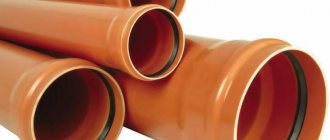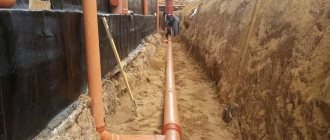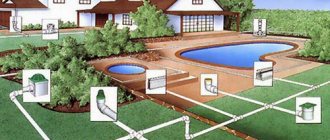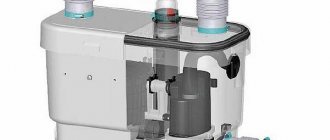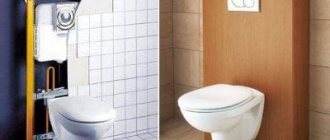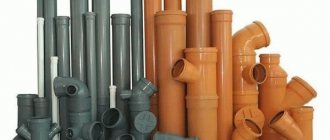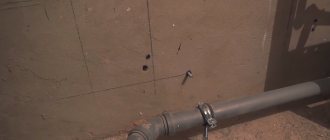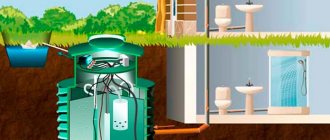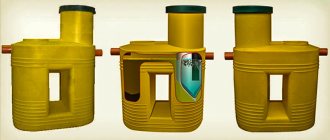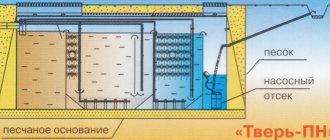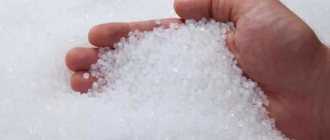Drain pipes for sewerage are products that are used in the installation of sewerage communications. These devices are classified primarily by the material from which they are made, as well as by purpose. Today there are many drain pipes that differ in functional characteristics. In order to select the necessary products for a specific situation, you need to pay attention to their characteristics.
The drain pipe is an important part of the sewer system of the house; the operation of all plumbing fixtures depends on its quality and correct installation.
No. 1. Material of internal sewer pipes
Internal sewerage can be done using the following pipes:
- cast iron. Previously they were installed everywhere, but today they are practically not used;
- polyvinyl chloride (PVC);
- polypropylene. Looking ahead, we note that this is the most optimal option;
- polyethylene. Infrequently used;
- steel and copper. Expensive pipes that are not used, but are sometimes still used due to their appearance.
Despite the fact that polypropylene and PVC pipes are most widespread, when choosing, do not rush to immediately discard the other options, since in some cases cast iron and even copper pipes may be useful.
Ceramic pipes
This is the most ancient material of all, which is gradually being used less and less.
Advantages:
- neutrality to chemicals,
- smooth inner surface,
- resistance to temperature changes,
- easy installation.
Flaws:
- fragility,
- short length of one pipe.
Ceramic products used to be excellent for sewerage. But now many other materials that are lighter or stronger have similar properties.
No. 2. Cast iron pipes for internal sewerage
Several decades ago there was no particular alternative to cast iron pipes, so they are widely found in old houses. Today, cast iron is being replaced by plastic, but is still used. Such pipes are made from gray cast iron by centrifugal casting. To protect the material from corrosion and make the internal surface smooth, the pipes outside and inside are coated with a bitumen compound. The diameter of cast iron pipes ranges from 5-15 cm, the wall thickness is 10-12 mm.
Advantages of cast iron pipes:
- durability. The service life reaches 50 years and often exceeds this mark. Some data suggests a longevity of 90-100 years;
- high strength and resistance to deformation. On the other hand, the material does not tolerate shock loads well;
- the ability to withstand long-term exposure to hot waste (from a washing machine or dishwasher, for example);
- resistance to temperature changes;
- fire resistance;
- environmental Safety;
- good sound insulation.
Surely, cast iron pipes would have remained among the leaders if not for significant shortcomings:
- the walls become overgrown with sediment over time. This is all due to the roughness of the material, which even with a bitumen coating cannot be completely eliminated. The process of overgrowing leads to a narrowing of the pipe lumen and a decrease in its throughput. Anyone who has seen what a pipe looks like after many years of use will never forget this terrible sight;
- heavy weight of pipes, which complicates transportation;
- complex installation, which is explained not only by the large weight, but also by the peculiarities of connecting pipe sections. In order for the sewer system to be airtight, it is necessary to correctly connect the elements. Usually they use the method of caulking or caulking using a heel;
- susceptibility to corrosion processes;
- high price.
Cast iron pipes are not used today to build a new sewer system, but they may be needed when existing systems are being reconstructed. At the moment, the use of cast iron pipes is also justified when arranging external sections of private sewers and intra-house risers.
When choosing, it doesn’t hurt to carefully examine the products and tap each of them. This way, it is easy to detect cracks and other defects that form when the manufacturing process is disrupted. A defective pipe does not have a long service life. Various types of fittings, plugs and sockets are produced for connecting cast iron pipes.
Asbestos cement pipes
Asbestos-cement pipes are durable, which is why sewer pipelines are made from them. Cement and asbestos fiber are not destroyed by rot, acids or corrosion.
Advantages:
- cheapness,
- durability,
- resistance to acids, alkalis, aggressive environments,
- strength,
- ease of installation,
- resistance to clogging.
Flaws:
- fragility, instability to mechanical stress,
- harm to people and the environment.
Given their low cost and durability, asbestos-cement pipes are not the best option. They are more difficult to transport and install than polyplastic - the weight is higher than that of polymers.
Also, asbestos cement crumbles at the edges, which is why the tightness is compromised if the connections are incorrect or of poor quality. The most dangerous, especially for internal connections: the environmental damage of asbestos concrete. Asbestos releases carcinogens; it is dangerous to work with and live near it.
No. 3. Polyvinyl chloride (PVC) sewer pipes
For arranging internal sewerage, PVC pipes are considered almost the most suitable option. During the production process, some other substances are added to polyvinyl chloride, which include stabilizers and polymers. Elements of the required shape are formed from the heated mass.
PVC pipes can be of two types:
- pipes made of plasticized PVC (PVC) have good elasticity and low strength;
- pipes made from unplasticized PVC (PVC-U) are more rigid and resistant to aggressive influences.
Of course, it is better to use unplasticized PVC, but in practice both types of pipes are used. The diameter of the products ranges from 2 to 20 cm.
Main advantages:
- affordable price;
- light weight;
- ease of installation. Separate sections of pipes are connected by couplings and connecting rings - everything is done without welding;
- low temperature coefficient of expansion. With a short-term or constant increase in the temperature of the drains, the pipes will not sag;
- sufficient strength and durability up to 50 years;
- sufficient resistance to ultraviolet rays, so that some sections of pipes can not be afraid to run on an open surface;
- resistance to corrosion and some aggressive substances;
- Thanks to the smooth inner surface, the walls do not silt over time.
Minuses:
- limited operating temperature range. With constant exposure to negative temperatures, pipes become fragile and lose their tightness, and with constant exposure to temperatures above +60...+700C, the material can deform and also lose integrity;
- insufficient fire resistance;
- The inner walls of PVC pipes are smoother than those of cast iron, but over time they will still develop plaque. In addition, the internal diameter changes over the years. As a result of exposure to high temperatures, the circular cross-section is transformed into an ellipsoidal one, and this impairs the throughput and contributes to the occurrence of leaks;
- some aggressive substances contained in drains can still lead to the gradual destruction of pipes.
To install internal sewerage from PVC pipes, appropriate connecting elements are used. These include an elbow designed to rotate the pipeline at an angle from 20 to 87 degrees, a tee for arranging branches, a cross for connecting four pipes, and a reduction for connecting sections of pipes of different diameters.
Advantages of plastic drain pipes
Let us consider in more detail the main advantages of using polymer products when installing internal and external sewer drainage communications:
- reasonable price. Plastic costs an order of magnitude less than any other material, which is very beneficial;
- light weight. Thanks to this, plastic parts are easy to transport and lay;
- durability. The service life of such plastic parts during normal operation can reach up to 50 years;
- resistance to destructive corrosive influences, as well as to aggressive chemical compounds. Many aggressive chemical compounds are transported through drain lines, so this property is very important and is taken into account when choosing and laying sewer drain lines;
Polymer pipes are very durable and perform their functions properly even when laid underground without any insulation
- low thermal conductivity. This property is especially important in regions characterized by low temperatures. Due to the low thermal conductivity of plastic pipes, the contents transported through them do not freeze;
- a large selection of products, which allows you to mount a structure of almost any configuration;
- environmental friendliness. During operation, plastic products do not emit substances harmful to human health, such as asbestos pipes.
No. 4. Polypropylene sewer pipes
Polypropylene pipes today are actively used in the arrangement of heating systems, cold and hot water supply. The properties of a material strongly depend on its structure. Pipes made from a copolymer of propylene and ethylene ( PPR ) are suitable for internal sewerage; they can withstand temperatures up to +700C. the PPs type behave even better , which can easily withstand temperatures up to +950C and short-term exposure to even higher temperatures. Reinforced pipes will be more durable, and fiberglass reinforcement is considered optimal. The product labeling also indicates the operating pressure: for internal sewerage, PN10 (withstand 1MPa), but more often they take PN20.
Advantages:
- durability up to 50 years;
- resistance to corrosion and almost all aggressive substances (acids, alkalis and salts will not damage the material);
- high strength of pipes and connections. Polypropylene is stronger than polyethylene and PVC, it is more resistant to cracks, and joints are less likely to depressurize;
- light weight;
- an absolutely smooth inner surface, so there will be no problems with pipe overgrowing;
- resistance to high and low temperatures, which allows the pipes to be used in almost any conditions. The pipes are not deformed;
- relative ease of installation. The connection of individual sections is made with a special welding machine, which almost anyone can learn to work with;
- relatively low price, but polypropylene pipes will cost more than polyvinyl chloride pipes;
- polypropylene type PPs belongs to the group of flame-resistant materials.
Among the disadvantages of polypropylene pipes, one can note only temperature deformation, so they will either have to be insulated or equipped with compensators.
PVC pipes
PVC or uPVC - polyvinyl chloride, a new polymer material. PVC pipes are lightweight, environmentally neutral and easy to install.
Advantages:
- long service life,
- no overgrowth,
- resistance to acids,
- wear resistance,
- ease.
Flaws:
- inoperability at temperatures below −10°C,
- deform (elongate) at temperatures above 60°C.
Gray PVC pipes are excellent for indoor sewerage, where they are used. Red PVC pipes for sewerage with hardness SN-4 and higher can be used for external pipelines.
To connect, the pipes are inserted into each other: at one end of the pipe there is a socket with a rubber ring, and at the other there is a chamfer that is tightly inserted into this socket. The inner surface of PVC pipes is perfectly smooth, so they rarely become clogged or overgrown.
Such pipes should be buried deeply, otherwise they will freeze. Also, you should not drain liquids with a temperature above 60°C through them for more than a minute. For a short time they can withstand temperatures exceeding 95°C.
No. 5. Polyethylene sewer pipes
Polyethylene pipes are rarely used in the construction of internal sewage systems. Typically, either low-density polyethylene or cross-linked polyethylene . The first option can withstand a maximum of +400C, so it makes sense to use it only in places with cold drains. Cross-linked polyethylene is designed to operate at temperatures of 0...+950C; for a short time it can withstand temperatures from -50 to +1200C, so it is usually used. The material has the following advantages :
- high strength, wear resistance and flexibility;
- corrosion resistance;
- smoothness of the walls and almost complete resistance to the formation of growths;
- light weight;
- resistance to pressure changes;
- durability;
- flexibility and easy installation;
- relative availability in terms of price.
Minuses:
- fear of ultraviolet rays;
- Oxygen can pass through the material, which will damage the metal elements in the system. The manufacturer applies a special coating, but it is quite delicate, so during installation you must be extremely careful so as not to damage it;
- low abrasion resistance.
PE pipes KORSIS and KORSIS Eco
Polyethylene is another polymer. KORSIS and KORSIS Eco pipes are made of high-density polyethylene (HDP) and an external corrugated layer is added. It increases ring rigidity, so the products are suitable for external sewerage.
Advantages:
- durability,
- ease,
- elasticity,
- frost resistance down to −60°C,
- resistance to acids and alkalis,
- soundproofing,
- polished inner surface.
Flaws:
- sensitivity to sunlight,
- maximum temperature of the transported substance: 80°C.
Pipes made of high-density polyethylene, unlike PVC, tolerate low temperatures. At the same time, they are also lightweight, elastic and more reliable for external pipelines.
sells polymer pipes made of PVC and high-density polyethylene. SIS is the official distributor of the Poliplastik Group, a manufacturer of plastic pipes for sewerage, water supply, and heating. SIS sells products from the Polyplastic Group at prices from the manufacturer, and also helps you choose material for pipelines.
No. 6. Copper and steel sewer pipes
Copper and steel pipes can be called ideal in terms of durability , strength and corrosion resistance. They can withstand any temperature and pressure, are characterized by minimal thermal expansion, and have a smooth, non-overgrowing inner surface.
The main disadvantage is the high price. In addition, copper pipes require specific installation, which only a professional can handle.
It is justified to use such an extravagant version of sewer pipes when open installation is carried out, and plastic pipes will look ridiculous. Copper pipes are often used when creating a retro interior with a claw-foot bathtub.
PP pipes
Polypropylene or PP pipes are also a new plastic building material with high strength values.
Advantages:
- resistance to high and low temperatures,
- durability,
- ease,
- resistance to acids and alkalis,
- strength,
- ease of installation.
Flaws:
- instability to temperatures above 80°C.
The disadvantages of PP pipes relate to temperatures above 95°C and work with fire-hazardous objects. High temperatures have a bad effect on polypropylene, as well as on other polymer materials.
In general, this material is excellent for any sewer systems. PP pipes are used for storm drainage, in private houses and apartment buildings due to their strength and wear resistance.
No. 7. Size and diameter of sewer pipes
Before you start purchasing and installing sewer pipes, it is best to draw up a project where you indicate all the drain points and the type of plumbing equipment. This will help you figure out what diameter and length of pipes are needed. At this stage, it also doesn’t hurt to determine the number of auxiliary parts, which will depend on the number of turns and branches. Take into account the change in pipeline diameter in individual sections.
Depending on the type of plumbing fixture being connected, pipes with different diameters are selected:
- a sewer pipe with a diameter of 25 mm is suitable for a dishwasher and washing machine;
- for bathrooms, showers and kitchen sinks – 40-50 mm;
- for washbasin and bidet – 30-40 mm;
- for pipe routing – 40-50 mm;
- bends from the riser – 65-75 mm;
- the central riser and pipe from the toilet are 100-110 mm.
It is better to add a margin of 10% to the calculated length.
Pos
How to replace drain pipes?
The process of replacing the drain pipeline is a rather complicated undertaking, however, if desired, you can do it yourself. To replace sewer drain pipes, you need to understand the process and have the necessary tools available.
Let's look at the list of tools that are needed to replace the drain pipe:
- Bulgarian;
- perforator;
- Screwdriver Set;
- pliers;
- hammer;
- chisel;
- adjustable wrenches;
- special sealant (preferably silicone based).
Before you begin directly replacing pipes, you need to make an accurate calculation of the materials that will be needed for this process. In addition, it is necessary to think in advance and draw up a plan for the passage of the new drainage sewer system. And do not forget about the main thing - the correct selection of individual elements of such communication (in terms of cross-section, length, etc.).
Before replacing the old sewer system, it is necessary to prepare new pipes of a suitable cross-section and connecting elements to them
If all of the above points are met, then you can begin replacing the drainage system. First of all, you need to turn off the water, and then begin dismantling the old communications. In order to simplify the dismantling work, it is recommended to remove all unnecessary objects from the bathroom, including the sink. This will allow you to gain more space and make dismantling old pipes as convenient as possible, and this measure also eliminates possible damage to plumbing fixtures and washing equipment.
After dismantling the old pipeline, it is necessary to prepare all the tools for laying a new drainage system. The first water intake point is usually the toilet.
Important! When installing a new drain, you must be careful and apply sealant to the joint before joining two pipes. This will increase the sealing performance of the system.
Thus, the installation of all drainage sewer pipes is carried out. Let's consider a few more important rules that are worth remembering:
- When laying a new communication, it is necessary to take into account that it must have a certain slope towards the central riser. As a rule, this slope is 5°;
- It is recommended to install a special cuff under each corrugated pipe;
- experts do not recommend cutting individual elements of the drain pipe
The slopes and cross-sectional indicators of the drain pipes are indicated in Table No. 1.
Table 1
| Santekhpribor | Required slope | Pipe cross-section for the drain system, mm |
| Main riser | — | 100 |
| Branch from the main riser | — | 65–75 |
| Bath | 1:30 | 40 |
| Sink | 1:12 | |
| Toilet | 1:20 | 100 |
| Bidet | 30–40 |
If all the above points are observed, the new communication will last for many years. Otherwise, the risk of system breakdown in the first days of its operation increases, so it is imperative to take this matter seriously.
Dismantling old drain pipes is a rather labor-intensive operation.
Popular materials
Let's look at the most popular solutions regarding working materials. There are several acceptable options for external sewer pipes. Not all of them are universal, but this is not required.
Most often, during installation work, products from the following materials are used:
- Cast iron
- Asbestos
- Polyethylene
- Polypropylene
- Polyvinyl chloride
The first two options are older and time-tested. Nowadays they are rarely used. Polyethylene, polypropylene and polyvinyl chloride samples are classified as polymer pipes. They are the future of sewer piping.
So what does each material on the list boast?
Cast iron
Cast iron sewerage is the oldest and most durable. It was used hundreds of years ago. The properties of cast iron as a durable metal with excellent corrosion resistance have been known for a long time.
Cast iron products can be found in the development of old sewer systems, so very often builders even today have to interact with them.
Disadvantages - difficulty in installation, huge weight, for work on connecting individual sections it is necessary to use a lot of additional materials and equipment.
External sewage system made of PVC pipes
A cast iron pipe, even a relatively small diameter for sewerage (up to 110 mm), cannot be lifted and installed manually. And this, you see, is a huge minus.
Asbestos
Asbestos pipes are similar to cast iron pipes in that previously builders used them exclusively. Asbestos and asbestos-cement products are lighter than concrete, but are not inferior to it in strength. They are cheaper, more reliable, more convenient, and easier to install.
It is customary to assemble external central sewerage from asbestos. It is unwise to introduce asbestos blanks into a building.
Unfortunately, due to its characteristics, asbestos also requires some tinkering during installation. Such pipes can only be connected using special means. It will not be possible to form a completely sealed connection. Consequently, asbestos-cement blanks can only be used for non-pressure sewerage.
Polyethylene
Polyethylene pipes are produced in different variations. The most famous and reliable are corrugated polyethylene sewer blanks.
Corrugated pipes are pipes with a ribbed wall. When laying internal pipelines, corrugated models are used to form flexible pipe connections.
Corrugated polyethylene pipes
Sewer corrugated samples are not flexible. They are made from high-strength polyethylene, with a diameter of 110 mm.
Corrugated pipes of this type have a ribbed outer wall made of durable protective polyethylene, and an inner smooth wall, which allows any waste and drainage to pass through the pipeline without hindrance.
Corrugated samples of external sewerage systems, as practice has shown, are of better quality and stronger than conventional ones, especially when compared with PVC products. Their price is also higher, but believe me, it's worth it.
Polypropylene
However, there are polypropylene corrugated pipes that are, by and large, a combination of several solutions at once.
Polypropylene is rightfully considered the best pipe polymer. It is stronger than other plastic products, can withstand more loads, and does not react to corrosion.
And, very importantly, it has a minimum coefficient of thermal expansion. That is, PP pipes can be installed in pressure sewers of a domestic or industrial type
In residential construction, polypropylene is used mainly for equipment of water supply systems and internal sewerage. There are only a few design solutions for outdoor use, and even those are significantly inferior to competitors in terms of price, although they are qualitatively superior in terms of characteristics.
Polyvinyl chloride
PVC or polyvinyl chloride is widely used in the production of sewer pipes. In some categories, it has practically supplanted all competitors.
The advantages of PVC are obvious. With a low price and production cost, the pipes made from it are excellent. Their strength indicators are not much inferior to polyethylene ones, they are connected very easily (the most popular method of connection is in a socket), like other polymers, they do not react at all to external irritants and are very durable.
PVC blanks are produced for both internal and external sewerage. Internal PVC sewer products are painted in light or gray colors. Materials for external sewerage are painted in orange or brown tones.
Technical features of selection for each drain point
- If you need a drain pipe for a toilet, then a corrugated pipe with a diameter of 110 mm is perfect for this task. Due to its flexibility, such a product will be easy to install and connect to any toilet model.
Tip: It is recommended to choose a model with thick walls. This way you will prevent it from being wiped quickly.
Connecting a toilet using corrugation
- If you need a drain pipe for a bathroom, then in this case it is possible to use both corrugated and smooth rigid polypropylene products. If there is enough space to accommodate two knees, then it is better to use the second option, but if space is limited, then the first one will do. The suitable diameter for such a waste channel is 40 mm.
Connecting a bathtub using a rigid elbow
Tip: do not forget to maintain a suitable slope from the bathtub to the riser when connecting. Otherwise, the system will not function properly.
- Need a sink drain pipe? Here again, a corrugated product is most often used, but its diameter can already change and be equal to 32, 40 or even 50 mm, it depends on the siphon and sink.
Kitchen sink drain system
- If a drain pipe from the roof is needed, then products with a rigid wall made of HDPE or polypropylene are suitable. But the diameter will depend on the size of the building:
| Building size | Suitable range of section sizes, mm |
| Small |
|
| Average |
|
| Big |
|
Fragment of a roof drainage system
The connection of the washing machine drain to the sewer pipe is usually done using a special corrugated hose included in the kit, through a siphon or a fork under the sink.
Connecting the washing machine drain hose
Requirements for pipes for external sewerage
Requirements for materials used in the installation of external sewer systems include compliance with a number of conditions, including:
- Greater strength compared to pipes used in the building's internal distribution system. In addition to the load experienced during transportation of waste, they must be able to withstand the pressure of the soil layer above them and be resistant to the effects of temperature and climatic environmental factors.
- Reliability that ensures their operation throughout the year with the possibility of carrying out work in winter.
- Resistance to corrosion and wear under the influence of chemical, biological and temperature factors.
- Resistance to temperature changes and the ability to provide the necessary performance in winter.
- The roughness of the internal surfaces of the pipes is as low as possible, which does not impede the drainage of waste and ensures a reduction in the diameter of the pipe when it becomes clogged.
- Light weight, facilitating installation of the structure and does not require additional devices or special tools.
- Possibility of connecting all necessary elements of internal and sanitary communications.
- Durability in operation, allowing the use of elements of the external sewage system for more than 50 years.
- Low cost, providing the ability to lay an extensive communications network.
To summarize, the pipes used to construct an external sewage system must ensure the serviceability of the system and reliable drainage of sewage throughout the entire period of operation.

